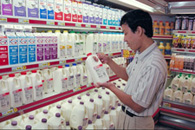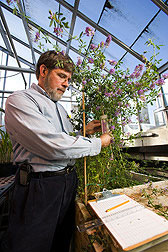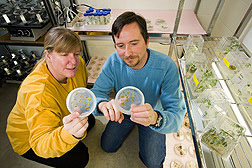Unique in Our Field
The U.S. Dairy Forage Research Center is one of about 100 units in the Agricultural Research Service (ARS) of the U.S. Department of Agriculture (USDA). We're the only USDA-ARS unit with the mission of improving forage use by dairy cattle.
Our Mission
To develop knowledge and tools to enhance sustainable and competitive dairy forage systems that protect the environment, promote animal health, and ensure a safe, healthy food supply.



Our Research
At the U.S. Dairy Forage Research center we are:
- Designing forages that lose less protein when harvested and stored;
- improving methods for harvesting and storing forages to capture and retain more nutrients;
- determining how the cow best utilizes those valuable nutrients in forages;
- reducing the amount of nutrients, such as nitrogen and phosphorous, that are lost to the environment;
- transferring our knowledge of forages and ruminal fermentation to the emerging bioenergy field.





Our Scientists
To solve problems that are national in scope, we take a multidisciplinary approach to our research—dairy and forage together. You can't improve a plant without knowing how it works in the cow. Our scientists have different areas of expertise, and they work together to make sure all bases are covered, from soil to milk.
Our research team is led by 21 scientists:
- 6 dairy scientists
- 3 agronomists
- 3 soil scientists
- 2 agricultural engineers
- 2 plant geneticists
- 2 plant physiologists
- 2 microbiologists
- 1 chemist



Research for Today's Challenges
Major areas of emphasis for research include:
- Identifying cell wall factors that limit digestibility and forage utilization in dairy cattle in order to increase the energy available from forages;
- completing a system that will provide site-specific nutritive values for feeds, taking into account such factors as crop growing conditions and methods of harvest, not just chemical analysis;
- integrating crop, pasture, and manure managment and studying how they impact the socio-economic and environmental aspects of dairy forage systems;
- creating value-added products from plant materials in order to increase the amount of environmentally friendly forage that is grown in the U.S. and to help create sustainable jobs in the rural sector;
- maximizing protein efficiency in dairy production to improve dairy farm profits and reduce the amount of nitrogen being added to the environment;
- designing forage plants with enhanced value for dairy production, profitability, and sustainability—plants that will reduce protein degradation during harvest and ensiling and enhance intake and digestibility in the cow.























